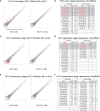Hepatitis C Virus Infection Cycle-Specific MicroRNA Profiling Reveals Stage-Specific miR-4423-3p Targets RIG-I to Facilitate Infection
- PMID: 35402303
- PMCID: PMC8987439
- DOI: 10.3389/fcimb.2022.851917
Hepatitis C Virus Infection Cycle-Specific MicroRNA Profiling Reveals Stage-Specific miR-4423-3p Targets RIG-I to Facilitate Infection
Abstract
Hepatitis C virus (HCV) infection is one of the main causes of chronic liver diseases, the disorders of which involve multiple pathological processes and elements including host factors such as non-coding small RNAs. Although several genes have been reported to be correlated with HCV infection, the potential regulatory network has not been deciphered clearly. By small RNA sequencing, we clarified the expression profile of microRNAs (miRNAs) in HCV-infected Huh7 and Huh7.5.1 cells and identified 6 dysregulated miRNAs with the same expression trend and 32 dysregulated miRNAs with different expression trends during different stages of HCV life cycle. By looking into each infection stage, we found that 6 miRNAs were entry stage specific, 4 miRNAs were replication stage specific, and 1 miRNA was related to the transmission stage. Moreover, due to the fact that Huh7.5.1 cells have a retinoic acid-inducible gene 1 (RIG-I) mutation which causes reduced production of interferons (IFNs), we here focused on the miRNAs of different trends to decipher the RIG-I/IFN specific miRNAs. Among them, miR-4423-3p showed a significant promotive effect on HCV infection by suppressing RIG-I/IFN pathway through direct binding to RIG-I mRNA. Together, the results displayed novel insights into the miRNA regulatory networks in HCV infection and progression, thus providing a prosperous perspective into the establishment of novel therapeutic and diagnostic targets of the disease.
Keywords: RIG-I; hepatitis C virus; miR-4423-3p; microRNA; small RNA sequencing.
Copyright © 2022 Qian, Wu, Xu and Qi.
Conflict of interest statement
The authors declare that the research was conducted in the absence of any commercial or financial relationships that could be construed as a potential conflict of interest.
Figures






Similar articles
-
Retinoic acid inducible gene-I (RIG-I) signaling of hepatic stellate cells inhibits hepatitis C virus replication in hepatocytes.Innate Immun. 2013;19(2):193-202. doi: 10.1177/1753425912460414. Epub 2012 Oct 11. Innate Immun. 2013. PMID: 23060457 Free PMC article.
-
Hepatitis C virus-mediated enhancement of microRNA miR-373 impairs the JAK/STAT signaling pathway.J Virol. 2015 Mar;89(6):3356-65. doi: 10.1128/JVI.03085-14. Epub 2015 Jan 14. J Virol. 2015. PMID: 25589644 Free PMC article.
-
Dysregulated Serum MicroRNA Expression Profile and Potential Biomarkers in Hepatitis C Virus-infected Patients.Int J Med Sci. 2015 Jul 16;12(7):590-8. doi: 10.7150/ijms.11525. eCollection 2015. Int J Med Sci. 2015. PMID: 26283876 Free PMC article.
-
MicroRNA-mediated interactions between host and hepatitis C virus.World J Gastroenterol. 2016 Jan 28;22(4):1487-96. doi: 10.3748/wjg.v22.i4.1487. World J Gastroenterol. 2016. PMID: 26819516 Free PMC article. Review.
-
Targeting miRNAs to treat Hepatitis C Virus infections and liver pathology: Inhibiting the virus and altering the host.Pharmacol Res. 2013 Sep;75:48-59. doi: 10.1016/j.phrs.2013.03.004. Epub 2013 Mar 27. Pharmacol Res. 2013. PMID: 23541631 Review.
Cited by
-
MicroRNAs in the Regulation of RIG-I-like Receptor Signaling Pathway: Possible Strategy for Viral Infection and Cancer.Biomolecules. 2023 Sep 4;13(9):1344. doi: 10.3390/biom13091344. Biomolecules. 2023. PMID: 37759744 Free PMC article. Review.
-
Host Factors Modulate Virus-Induced IFN Production via Pattern Recognition Receptors.J Inflamm Res. 2024 Jun 12;17:3737-3752. doi: 10.2147/JIR.S455035. eCollection 2024. J Inflamm Res. 2024. PMID: 38882189 Free PMC article. Review.
References
-
- Bandyopadhyay S., Friedman R. C., Marquez R. T., Keck K., Kong B., Icardi M. S., et al. . (2011). Hepatitis C Virus Infection and Hepatic Stellate Cell Activation Downregulate miR-29: miR-29 Overexpression Reduces Hepatitis C Viral Abundance in Culture. J. Infect. Dis. 203 (12), 1753–1762. doi: 10.1093/infdis/jir186 - DOI - PMC - PubMed
Publication types
MeSH terms
Substances
LinkOut - more resources
Full Text Sources
Medical
Molecular Biology Databases

